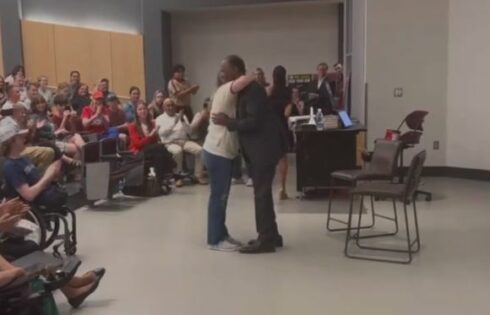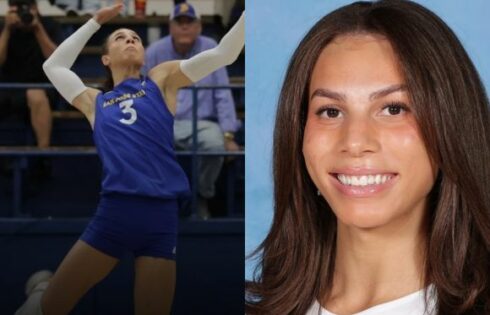
Every summer for the past seven years, San Diego State University has held a flag-raising ceremony at which a rainbow-colored flag is flown to tout the public university’s support for the Lesbian, Gay, Bisexual, Transgendered and Queer community.
The event typically coincides with San Diego’s Pride Week, which aims to “foster pride in and respect for all lesbian, gay, bisexual and transgender communities, locally, nationally, and globally.”
This year’s ceremony was marked by the participation of some venerable Boy Scouts, there to celebrate the recent decision by the Boy Scouts of America to eliminate sexual orientation as criterion for membership.
SDSU’s President Elliot Hirschman lauded the event, and emphasized the inclusivity on campus, saying: “At SDSU, diversity and excellence go hand in hand.”
SDSU does have quite a commitment to diversity. I know, because I’m spoon-fed it at nearly every turn.
On its news site, there is a separate tab specifically devoted to diversity related articles. Not so for sports or the arts. One has to search to find the few stories devoted to those topics. Diversity cannot be avoided. It is right there, on the home page, with an easy-to-use tab.
I am hyper-aware of SDSU’s commitment to diversity as I apply for classes. I am at the point that I am taking mostly courses particular to my majors. I have completed all my general education requirements but one: an upper division social science, marked with an asterisk.
What does this asterisk indicate? It means a class that fulfills the cultural diversity requirement. At SDSU, a student cannot graduate without having taken a class that teaches about some minority culture, be it blacks, Chicanos, American Indians, or women. (How women rank as a different culture at a school where they constitute more than half of the student population is a matter I have yet to understand.)
It is, however, possible for a student to graduate without ever taking an American History course. I will.
I took an Advanced Placement United States history class in high school. My score on the test means I bypassed taking a similar course on a collegiate level. But even those who didn’t take AP history in high school can bypass American History at SDSU.
There is what is called the “American Institutions” requirement for graduation from SDSU, but this can just as easily be fulfilled by taking two courses in Chicana/Chicano studies as it can by taking American history.
There is no similar way to clear the cultural diversity requirement. Trust me, I tried.
As part of my Resident Advisor position, I was required to take a year-long Cultural Competency Certificate Program (I can’t make this stuff up).
Essentially, we were supposed to learn about other cultures and become more accepting and understanding of those different from us. We learned about the LGBTQ community, American Indians, racial models of development, people with disabilities, and white guilt. A whole year of that stuff, and I still have to take a class with an asterisk.
SDSU does have a rather diverse campus. I see and know people from all sorts of religious, ethnic and racial backgrounds. (Interestingly enough, diversity of thought is harder to find.) For that exact reason, it seems superfluous to require classes that teach acceptance.
SDSU is not a hotbed of racial or ethnic tensions. The SDSU campus climate reflects the typical Southern California laid-back attitude. Of course, some individuals have problems – that kind of stuff can never be completely eliminated. Overall, though, life goes on pretty swimmingly here.
I think that the people who decided such classes are necessary were born in a time and place where diversity was not an automatic. Back then, it really would have been novel to meet somebody of a different skin color or religious belief. But for most students these days, it is nothing new. It is just a fact of life. I would bet on the fact that every student at SDSU has a Latino friend and could talk ad nauseum about DOMA.
Meanwhile, anecdotally at least, many students here probably can’t name the current Secretary of State or cite in what founding document the separation between the various offices of government was established.
Maybe that sort of knowledge is no longer important. Anything can be Google searched on the go.
Our unity as a nation is borne of our recognition that we share something greater than ourselves. But as knowledge of our collective history as Americans is being supplanted by diversity education, that bond weakens.
We see ourselves as an odd collection of mismatched races, religions, and sexual orientations. Sometimes those differences don’t mix. Ironically, the more we teach diversity, the less cohesive we become.
Fix contributor Emily Yavitch is a student at San Diego State University.
The event typically coincides with San Diego’s Pride Week, which aims to “foster pride in and respect for all lesbian, gay, bisexual and transgender communities, locally, nationally, and globally.”
This year’s ceremony was marked by the participation of some venerable Boy Scouts, there to celebrate the recent decision by the Boy Scouts of America to eliminate sexual orientation as criterion for membership.
SDSU’s President Elliot Hirschman lauded the event, and emphasized the inclusivity on campus, saying: “At SDSU, diversity and excellence go hand in hand.”
SDSU does have quite a commitment to diversity. I know, because I’m spoon-fed it at nearly every turn.
On its news site, there is a separate tab specifically devoted to diversity related articles. Not so for sports or the arts. One has to search to find the few stories devoted to those topics. Diversity cannot be avoided. It is right there, on the home page, with an easy-to-use tab.
I am hyper-aware of SDSU’s commitment to diversity as I apply for classes. I am at the point that I am taking mostly courses particular to my majors. I have completed all my general education requirements but one: an upper division social science, marked with an asterisk.
What does this asterisk indicate? It means a class that fulfills the cultural diversity requirement. At SDSU, a student cannot graduate without having taken a class that teaches about some minority culture, be it blacks, Chicanos, American Indians, or women. (How women rank as a different culture at a school where they constitute more than half of the student population is a matter I have yet to understand.)
It is, however, possible for a student to graduate without ever taking an American History course. I will.
I took an Advanced Placement United States history class in high school. My score on the test means I bypassed taking a similar course on a collegiate level. But even those who didn’t take AP history in high school can bypass American History at SDSU.
There is what is called the “American Institutions” requirement for graduation from SDSU, but this can just as easily be fulfilled by taking two courses in Chicana/Chicano studies as it can by taking American history.
There is no similar way to clear the cultural diversity requirement. Trust me, I tried.
As part of my Resident Advisor position, I was required to take a year-long Cultural Competency Certificate Program (I can’t make this stuff up).
Essentially, we were supposed to learn about other cultures and become more accepting and understanding of those different from us. We learned about the LGBTQ community, American Indians, racial models of development, people with disabilities, and white guilt. A whole year of that stuff, and I still have to take a class with an asterisk.
SDSU does have a rather diverse campus. I see and know people from all sorts of religious, ethnic and racial backgrounds. (Interestingly enough, diversity of thought is harder to find.) For that exact reason, it seems superfluous to require classes that teach acceptance.
SDSU is not a hotbed of racial or ethnic tensions. The SDSU campus climate reflects the typical Southern California laid-back attitude. Of course, some individuals have problems – that kind of stuff can never be completely eliminated. Overall, though, life goes on pretty swimmingly here.
I think that the people who decided such classes are necessary were born in a time and place where diversity was not an automatic. Back then, it really would have been novel to meet somebody of a different skin color or religious belief. But for most students these days, it is nothing new. It is just a fact of life. I would bet on the fact that every student at SDSU has a Latino friend and could talk ad nauseum about DOMA.
Meanwhile, anecdotally at least, many students here probably can’t name the current Secretary of State or cite in what founding document the separation between the various offices of government was established.
Maybe that sort of knowledge is no longer important. Anything can be Google searched on the go.
Our unity as a nation is borne of our recognition that we share something greater than ourselves. But as knowledge of our collective history as Americans is being supplanted by diversity education, that bond weakens.
We see ourselves as an odd collection of mismatched races, religions, and sexual orientations. Sometimes those differences don’t mix. Ironically, the more we teach diversity, the less cohesive we become.
Fix contributor Emily Yavitch is a student at San Diego State University.
Click here to Like The College Fix on Facebook / Twitter: @CollegeFix
IMAGE: A CLOCKWORK ORANGE




Please join the conversation about our stories on Facebook, Twitter, Instagram, Reddit, MeWe, Rumble, Gab, Minds and Gettr.